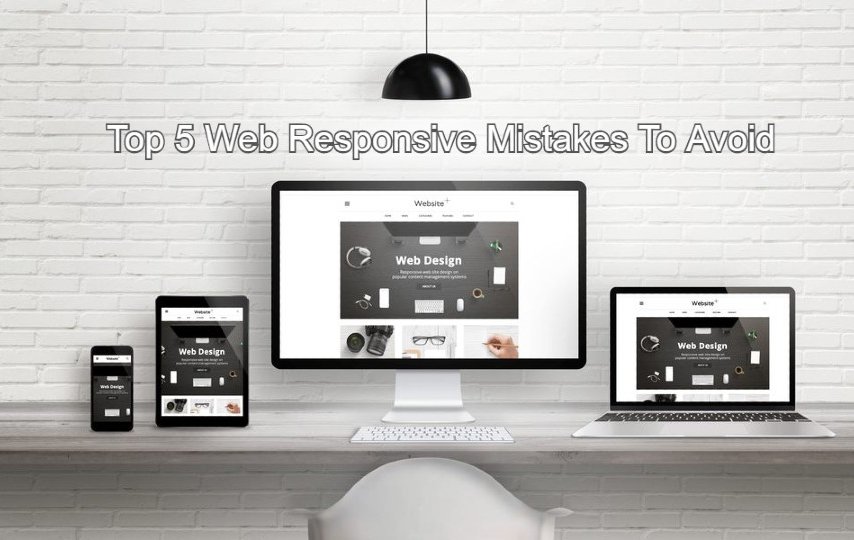With a breakthrough in innovation, there are many multimedia technologies like desktops, smartphones, tablets, smartwatches, etc. Research shows that almost 50 percent of web traffic originates from cell phones. Therefore, if you want to enhance your search engine optimization, you cannot disregard mobile phones.
If you do not have mobile-friendly web sites, then you may end up losing a big chunk of your audiences. It requires that your website must have a responsive design to adapt in response to different display sizes. One possibly cannot think of enjoying using a desktop version of a website on a small screen of a mobile phone.
Five Simple Responsive Design Mistakes Affecting Your Website Traffic.
When you are creating your responsive design, you will find yourself making mistakes that end up costing you a lot. To help you with your website, we have put together some possible responsive design mistakes and how to remedy them below.
1. Using the size of the device as breakpoints
According to the statistics, there were just over 24,000 different kinds of Android devices in 2015, and the number has been increasing steadily in the past five years. These devices are so versatile with different screen sizes and graphics too. With a vast difference in screen dimensions across devices, it is essential to get proper breakpoints. With correct breakpoints, you can ensure that your website presents a seamless browsing experience on all devices.
If you focus all your resources on just one device size breakpoints in your responsive design, your website might not appear correctly on other newer devices. Therefore, do not limit yourself to the size and dimensions of current devices for breakpoints estimation. A more practical approach is to go for a responsive design that can adjust well to any display size.
An excellent method for a responsive design is to take up the mobile-first approach. In this approach, you can first build your website for small screens and then slowly optimize for larger display sizes. You can also consult with website maintenance company in Dubai to help you with the responsiveness of your website.
Quick Tip:
If you concentrate on just the device’s display size breakpoints in your responsive design, then your website might not be appropriate for newer devices.
2. No consideration of file sizes
Visual elements and eye-catching graphics make your website more engaging, thus attracting more users. However, one must be very careful when adding graphics to your website. The majority of the time, your image/media file is considerably larger than your text file, which slows down your page, taking more time to load data. This highly affects website traffic.
As the loading time of your website increases, more and more users bounce to new sites with a faster response rate. According to Akamai, the bounce rates increase by 6 percent when it takes more than 1.5 seconds to load a page, especially during holiday seasons. The bottom line is to optimize your images and media files to reduce their size.
Apart from decreasing media file size, you can also opt for minifying CSS, HTML, or JavaScript files to speed up your website. Remove all third-party tools from the website to achieve maximum loading speed.
Quick Tip:
Keep the media file size as small as possible, without compromising the quality to increase page loading speed.
3. Not utilizing adaptive image management
When it comes to media files and images on your website, dimensions are as crucial as its file size. In conventional websites, you may not have to worry about the use of images of different dimensions. However, when it comes to a responsive design, mismanagement of images and other graphics can be damaging for your user experience.
The last thing a user wants to see is a large, misfit image on a small screen. To avoid this, make use of adaptive image management techniques. Following are some of the ways you can achieve perfect graphics and media for your website:
- Resolution: choose images with different resolutions.
- Device-pixel-ratio: make your media and images appear crisp by reducing perceptible artifacts based on display size.
- Viewport: change images based on the device used and their physical orientation.
- Art direction: crop and edit images based on the display to improve its quality and visual experience.
Quick Tip:
Adaptive image management is crucial for visual appeal and user experience of your website.
4. Hidden Content
One of the biggest mistakes that most of the website owners make while creating a responsive design is that of hiding content on their web platform. Hiding content may increase your page loading speed or help you in fitting your website on smaller screens. However, it must be avoided at all costs as it WILL direct traffic away from your website.
Always think from the user’s perspective. People are not coming to your website just for a small sample. They want a flawless browsing experience just like that on a desktop. It is necessary because users access your website from multiple devices daily. For that, it is essential to maintain consistency of content in responsive design.
Instead of hiding content, you can prioritize the content differently across different devices.
Quick Tip:
Instead of hiding content on your website, prioritize it differently across devices.
5. Keeping a Consistent Navigation
When it comes to website responsiveness, giving a consistent browsing experience to the user across all devices is essential. However, make sure consistency is not absolute and that there is some flexibility to cater to different display sizes. Most people commit a big mistake by keeping consistent navigation across all devices of different screen sizes.
Absolute navigation makes your website not pleasant to look at as the navigation bar may end up occupying most of the screen space, thus spoiling the browsing experience altogether. One way to avoid that is to shrink the navigation with screen size and use dropdowns.
Some of the things that you should keep consistent are the typefaces, color themes, and links.
Quick Tip:
Make sure your web navigation is adaptive for different devices, instead of being consistent.
Increase Website Traffic
Today’s digital age is marked with a plethora of devices ranging from desktops to mobile phones and tablets. If you wish to achieve maximum target audiences, then you must not avoid a responsive web design. However, be cautious while implementing it to avoid all possible errors and potholes.
To ensure that your website is compatible with all display sizes, you can also consult website maintenance professionals to ensure a responsive design for your website. Give your viewers a consistent, top quality browsing experience across all display sizes. Go for truly responsive designs, and don’t limit yourself to new opportunities.












